


A forest fire
which hems in a mountain-top mansion on every side and creeps gradually closer and closer
is a sinister background for the equally sinister tale of murder. It was murder with such
complicated and subtle clues that no one but Ellery Queen could have unraveled the tangled
web, and even he thought more than once that he held the end in his hands only to discover
that it was really a loose end. What was the mystery of the isolated mansion? Why had the famous
surgeon John Xavier, come there to live? Why was Marie Carreau, a society beauty
supposedly traveling in Europe, hiding in one of the rooms? What was the Thing which
Inspector Queen saw and could describe to his son only a giant crab? All the questions
puzzled Ellery even before the first murder - and then there was another one. "Who the devil do you think you are anyway?" Mark Xavier shouted. Ellery's father took a worn black case from his pocket and snapped the lid open. Inside lay a round embossed gold shield. "Inspector Queen of the Homicide Squad, New York City Police Department", he said. "I'm sorry I didn't announce last night that I'm a copper. "Because if I had, I'm certain that Dr. John Xavier would be alive this morning. And it's too damned beautiful a morning to be dead in." We've got to get under cover," Ellery Queen
insisted. "The house is burning now.... The cellar -- where's the cellar? Lord, what
unmitigated idiots! Talk, will you, somebody?" |
|||
|
"Mr. Queen handles his story elements-the growth of fear, the interplay of emotion, the delineation of common people helpless before an uncommon situation-equally as superbly as he does his mystery and detective elements, in the concoction and treatment of which he is a past master." "Here is a thriller and no mistake." -- Will Cuppy, New York Herald-Tribune |
|||
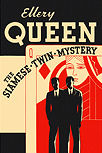    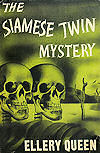     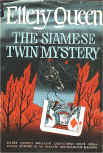  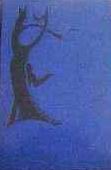 |
|||
| Above: The first books published sometimes had identical front covers. The spine of the books/dust cover only differ in the publisher's logo. Top row left to right: Both dust cover and hard cover for Stokes, Grosset & Dunlap & Triangle Books edition. Bottom row left to right: Another hard cover variation for the Triangle Books edition, dust cover and hard cover for the Center Books edition and finally dustcover & two hard covers for World Publishing Company, Tower Books edition (Click on the covers to see the differences) * | |||
| The Bulletin (Australia),
Jan 24, 1934 "The weakness of practically all American thrillers is stridency, a tendency to overstate everything. Ellery Queen's 'The Siamese Twin Mystery' is another of them. The characters shout at one another like lunatics, tremble, turn pale, 'sway with disbelief, nausea, mounting rage,' sit rigid, 'stand glaring with awful triumph like mythological figures of vengeance,' and so on. The reader longs for the disciplined restraint of the policemen in an English thriller as he considers the hysterical reaction of Inspector Queen to the loss of his ring. 'By God, I'll have the eye-teeth of the so-and-so who stole it... I'm going to search everyone down to their skins.' The plot is ingenious and there is an exciting finish." |
|||
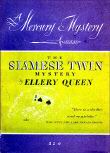        |
|||
| The
Siamese Twin Mystery, published in 1933, represents a distinctive entry in
the Ellery Queen canon, blending traditional Golden Age
detective mechanics with a more adventurous, narrative-driven approach. The
novel opens with Ellery Queen and his father returning from
a holiday and taking a detour through Arrow Mountain, only to find
themselves caught in a massive forest fire. This natural disaster isolates
them and brings them to the mansion of the renowned surgeon Dr. John Xavier,
setting the stage for a tense, claustrophobic environment where danger, both
natural and human, is inescapable. The mansion’s inhabitants, a mixture of peculiar and secretive figures, immediately arouse suspicion. Among them is Marie Carreau, a society beauty who claims to have been traveling in Europe but is now hiding in one of the rooms, and various others whose motives and connections are gradually revealed. The tension escalates when Dr. Xavier is murdered, his hand clutching a torn six of spades—a dying message that forms the core of the novel’s central puzzle. The mystery is compounded by bizarre elements such as a “Thing” seen by Inspector Queen that he can only describe as a giant crab, and the intricate interrelations of guests trapped within the fire-encircled mansion. The novel demonstrates Ellery Queen’s signature ingenuity, though it departs somewhat from strict “fair play” rules typical of Golden Age mysteries. While a map is provided, the closed-circle situation is “faux” in nature: the Queens, as established protagonists, are not truly in mortal jeopardy, and the forest fire serves as a narrative device to heighten suspense rather than as a real threat. Similarly, the dying message—a torn playing card—is used extensively, providing a complex but manageable puzzle around which the story is structured. This is the second time after The Tragedy of X (1931), the Queen hallmark of the "dying clue" was introduced. Critics have noted that the story features multiple potential solutions and intentionally misleading clues, illustrating what has been called “Later Period Queen problems,” where false deductions and planted evidence challenge both detective and reader to discern the truth. |
|||
          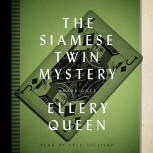  |
|||
|
The prose has drawn some criticism for its melodramatic
tendencies. Characters often react with exaggerated emotion, and the
narrative can be strident in its depiction of hysteria and outrage,
particularly in scenes of confrontation or revelation. Nevertheless, these
flourishes contribute to the heightened atmosphere of suspense and horror as
the forest fire encroaches and the murderer remains among the group. Despite these departures from strict detective orthodoxy, the novel showcases Ellery Queen’s deductive brilliance, culminating in a solution that, while slightly more intuitive than purely logical, is satisfying within the story’s tense and enclosed framework. The final confrontation forces the detective to reveal his reasoning quickly, under the imminent threat of the spreading fire, further emphasizing the novel’s dramatic tension. The Siamese Twin Mystery is often regarded as an important work in Queen scholarship, illustrating the evolution of the series’ narrative and structural techniques. It combines a compact, almost short-story-like central mystery with elements of a larger thriller, including natural disaster, peculiar characters, and a tightly constructed dying message. While not as rigidly analytical as some earlier works, it remains accessible, engaging, and a compelling example of Ellery Queen’s ability to blend intellectual puzzle with suspenseful storytelling. This novel is thus a slightly different Queen: more dramatic, more story-driven, but still thoroughly satisfying for readers who enjoy clever deduction and atmospheric tension. |
|||
Jeffersonian, January 26. 1934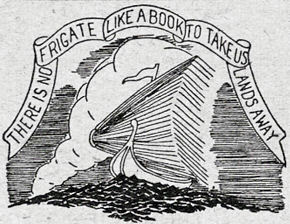 Frigates Prologue No masterpiece of author great Do I review today, But views about a humbler work Would I to you convey. A type condemned by critics as Not even literature, Detective stories ne'ertheless Contain for all a lure Review This book by noted Ellery Queen, The Siamese Twin Myst'ry, As it is called, is one that should Be Read exstatic'ly Consisting of macabre scenes, Laid on a mountain-top Ringed 'round by flame, the characters Have forced on them a cop. Inspector Queen is the cop's name, And with him, his son El-- These two become enamored with The eyrie's weird spell. Two doctors there are seeking rest At least ostensibly, While various house-guests of the plot, Do make a mystery. One of the elite upper set Seeks also refuge there, While her offspring, "Siamese" from birth, Do complicate the air. Two of the household are "knocked off," Then come the climax high. Though staged below, hemmed in by fire, The actors do not fry. Epilogue If this you cannot quite make out And read the meaning clear, I would suggest you get the book Your lonely hours to cheer. - Ed Roper - |
|||
|
Elements for "The Game" With plan but no challenge to the reader. Dr.Xavier is poisoned. When the victim has diabetes rigor mortis sets almost immediately, Ellery had encountered this once before (The Egyptian Cross ?) The story is set two days from New York on Arrow mountain (close to the Tomahawk valley in the Tepee mountains). Quiet accurately put at the 60th km on the road Tuckesas to Osquewa (which was 80 km in total).The Queens are returning from holiday in Canada in the Duesenberg which plays a major role at the beginning of the story. Often some new discoveries are featured in Queen books here a new medication is mentioned: alpha-lobeline. Ellery remarked that the etching on the wall was etched after the "grisly" Rembrandt painting The Anatomy Lesson. Ellery's mother is mentioned. Not so long ago he was in Florence were he bought a ring. He still wears a lorgnette and smokes cigarettes. Richard is close to sixty, uses his snuffbox and wears a cheap wedding ring. |
|||
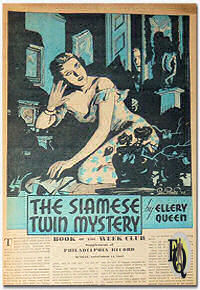  |
|||
| Above
left: Philadelphia Record Book Club section from 1937 Above right: 40th edition from the French magazine Yard (June 1952) featured Le Mystère des Frères Siamois de Ellery Queen. |
|||
|
|||
|
Other articles on this book (1) Solve-Along #3 Rich McD (May 2012) (2) Reading Ellery Queen Jon Mathewson (Jan 2014) (3) The Queen's Tale Ho-Ling (May 15. 2013) |
|||
|
*
Interested readers should know
that the icons/covers
of books, used throughout the
website have extra
descriptions/information not
included in the text on the same
page. Pointing your cursor at
the icon/cover used to reveal
this extra information. To achieve the same effect Firefox users can install an add-on called 'Popup ALT Attribute'. When installed pointing your cursor at an icon/cover results in showing you the details or additional information. |
|||
|
Copyright © MCMXCIX-MMXXIV Ellery Queen, a website on deduction. All rights reserved. |